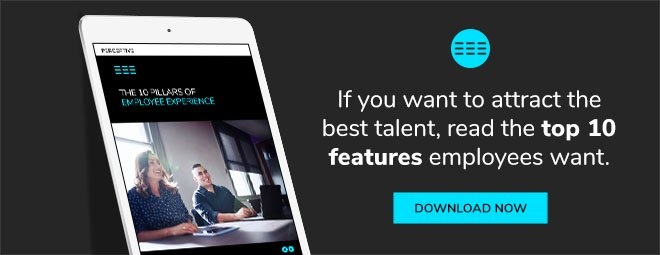Time and time again research has proven that diverse companies have better creativity, innovation, productivity, stronger talent, and customer service. In short, diversity gives your businesses an edge. And companies that excel in diversity are setting themselves up to be the all-stars of the business world.
But while New Zealanders like to think of ourselves as open to diversity, we still have issues integrating it into our workplaces. The New Zealand Workplace Diversity Survey 2020 has revealed what New Zealand workers consider the most important diversity issues in Kiwi workplaces. And it starts with well-being/wellness.
Related content: The 10 Pillars of Employee Experience
Well-being/wellness
Well-being and wellness is considered the number one diversity issue in New Zealand workplaces1. Mental health, stress and work-life balance are key factors in employee well-being, with mental health showing as the most significant wellness challenge for businesses since 2017.
According to the 2017/18 New Zealand Health Survey, one in six New Zealanders have been diagnosed with a common mental disorder at some time in their lives, including depression, bipolar and anxiety disorders. That’s over 800,000 people—more than the population of Christchurch, Wellington and Hamilton combined. Moreover, at the time of the survey, nearly nine per cent of adults had experienced psychological distress in the past four weeks.
Depression and anxiety are the most common disorders in New Zealand—but are by no means exclusive. And the types of disorders that fall under this dual umbrella are many and include phobias, post-traumatic stress disorder and obsessive-compulsive disorder.
The good news is that the majority (80.1 per cent) of Kiwi organisations already have a wellness policy and/or initiatives in place2. But we can still do more.
Three strategies to promote positive mental health at work:
- Create a positive, psychologically-healthy organisational environment.
- Have a proactive, fair and empathetic approach to mental health and mental illness in the workplace.
- Help employees engage in activities that boost positive mental health and well-being3.
For more details on what you might include in these strategies, take a look at Working Well: a workplace guide to mental health.

Gender equality
As sixth in the world for gender equality, and first in East Asia and the Pacific, New Zealand is leading the way in this issue4. However, one of the key criteria we fall down in is having male and female parity in legislators, senior officials and managers. Currently, we are ranked 105th with a split of 25.7 per cent female and 74.3 per cent male.
So why aren’t more women in senior positions? A lot of it comes down to lack of childcare support, namely flexible hours, part-time work and assistance managing childcare demands—which reduces women’s ability to work and pursue career opportunities.
Three strategies to promote gender equality in the workplace:
- Policies against discrimination and harassment in the workplace—which are swiftly acted upon if breached.
- Reevaluate your hiring and performance review practices, such as training to remove unconscious bias and using a diverse interview panel.
- Offer flexible hours and work from home options to allow women to balance their paid and unpaid workloads.
Read more potential initiatives you could implement on page 23 of The Future of Women at Work.
Ethnicity
While we’re getting better with cultural and ethnic representation in Kiwi workplaces, we still have a way to go. The New Zealand Workplace Diversity Survey 2020 places ethnic diversity in the top five most important diversity issues in New Zealand organisations.
In 2018 and 2019, businesses become more aware of their lack of ethnic diversity in the workplace, particularly with Māori and Pasifika representation. There’s also a growing awareness that companies need to do a better job of representing their clientele and community.
Awareness is one thing. Turning it into action is another. We made strides in 2019, with a 10 per cent uptick of companies working to create an inclusive workplace culture5. The 2020 survey, however, shows a 4 per cent drop, indicating there is still work to be done.
A workplace culture lives and dies by its leadership, and if managers and company leaders fail to role model inclusive behaviours, such as listening and asking questions to understand cultural differences, an initiative will fall flat.
“Diversity cannot thrive without a culture of inclusion,” Diversity Works New Zealand Chief Executive, Rachel Hopkins, tells Scoop Magazine. “The hallmark of an inclusive workplace culture is confident, inclusive leaders.”
Three strategies to promote equality in the workplace:
- Create a workplace culture that’s inclusive, equitable and respectful.
- Reevaluate your hiring and performance review practices, such as training to remove unconscious bias, using a diverse interview panel and hiring based on skill and qualifications alone.
- Implement culturally-appropriate service delivery.
For resources on eliminating bias during recruitment and practical tips for managing ethnicity in the workplace, visit here.
Older workers
In previous years, ageing and engaging the over 55 workforce has been the third most important diversity issue for New Zealand workplaces. But in 2019, its importance dropped to seventh place and stayed there in 20206. However, that’s not to say it’s less of an issue.
As of December 2019, there were over 29,000 55- to 64-year-olds on the jobseeker benefit, an increase of 1,500 people since the same time in 20187. What’s more, unlike well-being, gender equality and ethnicity, the majority of businesses don’t have policies and initiatives in place to support and engage over 55-year-old workers.
This issue is particularly pronounced when it comes to filling staff shortages. HR managers have more measures in place for recruiting female, immigrant or non-nationals workers to fill a personnel shortage than hiring new workers over 558.
Ageing is only going to become more prominent in the next two decades as Millennials—the largest generational cohort—approach retirement. Establishing and refining processes and policies to engage this workforce and harness their experience will become all the more vital.
Three strategies to support over 55 workers:
- Create a workplace culture that values experience and training, and encourage your ageing workers to mentor younger colleagues.
- Reevaluate your hiring and performance review practices and age-discriminatory biases (whether intentional or not). In particular, encourage HR to actively recruit older workers.
- Offer flexible or reduced hours.
Want to create an inclusive and positive workplace? Uncover the 10 Pillars of Employee Experience to engage your employees and build a healthy workplace culture.
- Diversity Works NZ, New Zealand Workplace Diversity Survey 2020, 2020.
- Diversity Works NZ, New Zealand Workplace Diversity Survey 2020, 2020.
- Mental Health Foundation of New Zealand. Working Well: a workplace guide to mental health. Auckland, New Zealand: Mental Health Foundation of New Zealand, 2016.
- World Economic Forum. The Global Gender Gap Report 2020, 2020.
- Diversity Works NZ, New Zealand Workplace Diversity Survey 2019 and New Zealand Workplace Diversity Survey 2018 (April), 2018-2019.
- Diversity Works NZ, New Zealand Workplace Diversity Survey 2020, 2020.
- Sarah Robson, Calls made for employers to change attitudes towards older workers, Radio NZ, 2020.
- Diversity Works NZ, Managing an ageing workforce, 2015.
